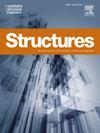Out-of-plane flexural behaviour of AAC masonry walls reinforced using steel wire mesh integrated within the masonry bed and bed-head joint
IF 3.9
2区 工程技术
Q1 ENGINEERING, CIVIL
引用次数: 0
Abstract
Autoclaved aerated concrete (AAC) masonry walls are vulnerable during seismic events due to their inherent brittleness, low toughness, low tensile strength, and susceptibility to out-of-plane loading. This study investigates an economical approach to enhance the lateral resistance and ductility of AAC masonry walls by embedding steel wire mesh within the masonry mortar bed joint, as well as the bed and head joint. Three different types of steel wire mesh and three reinforcing arrangements were evaluated for each approach. The (-) arrangement aligns the mesh width with the masonry width. The (L) arrangement involves attaching the mesh such that one side extends beyond the masonry mortar width, bending it to affix to the masonry face, forming a letter L shape. The (Z) arrangement showcases the mesh extending beyond both faces of the masonry width; one section is bent to rest on the masonry bottom face while another is bent and rests on the masonry top face, forming a letter Z shape. The results demonstrated a significant improvement in flexural capacity of the masonry, with the bed joint configuration outperforming the bed-head joint configuration. Among the reinforcement arrangements, the (Z) arrangement exhibited higher performance, followed by the (L) and (-) arrangement. Additionally, steel wire mesh with higher tensile strength demonstrates better performance, highlighting the critical role of the material property in the reinforcing efficiency. The analytical prediction based on a developed model were in reasonable agreement with the experimental outcomes. These findings highlight the practical significance of steel wire mesh reinforcement in enhancing the seismic resilience of AAC masonry structure.
求助全文
约1分钟内获得全文
求助全文
来源期刊

Structures
Engineering-Architecture
CiteScore
5.70
自引率
17.10%
发文量
1187
期刊介绍:
Structures aims to publish internationally-leading research across the full breadth of structural engineering. Papers for Structures are particularly welcome in which high-quality research will benefit from wide readership of academics and practitioners such that not only high citation rates but also tangible industrial-related pathways to impact are achieved.
 求助内容:
求助内容: 应助结果提醒方式:
应助结果提醒方式:


